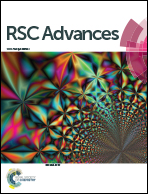Carbon nanotube-induced migration of silver nanowire networks into plastic substrates via Joule heating for high stability†
Abstract
The hydrothermal and mechanical stability of transparent conducting films is a prerequisite for commercial applications in optoelectronic devices. However, the environmental stability of silver nanowire (AgNW) transparent conducting films (TCFs) is not promising without post-treatment or overcoating with foreign materials. Herein, we reported that thermal embedding of silver nanowire networks assisted by single-walled carbon nanotubes (SWCNTs) via Joule heating is a straightforward method to enhance the hydrothermal stability and interfacial adhesion of flexible AgNW TCFs on plastic substrates. Under a direct current flow, the effective Joule heating of SWCNTs, which are thermally stable and compatible with hydrophobic substrates, led to the migration of hydrophilic AgNWs into the hydrophobic polycarbonate (PC) substrate without deforming it. The resulting flexible and transparent AgNW-embedded PC film exhibited long-term stability at high temperatures during heating and cooling cycles under high applied voltages, without requiring further passivation with other materials; therefore, it has the potential to be used in a broad range of applications such as optoelectronic devices and flexible thin-film heaters.


 Please wait while we load your content...
Please wait while we load your content...